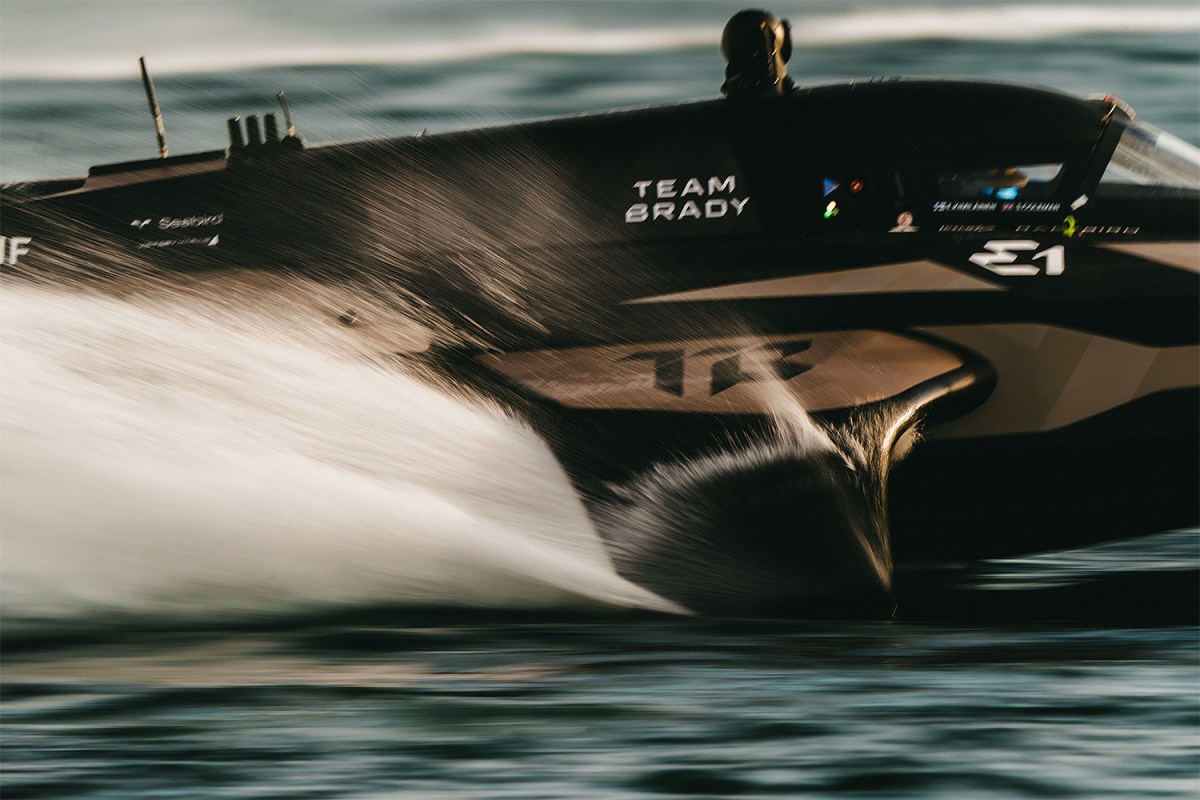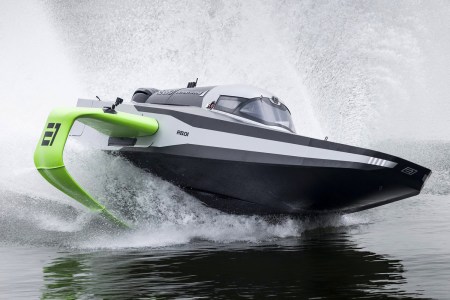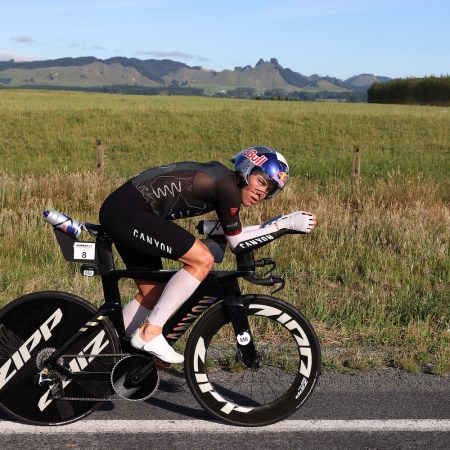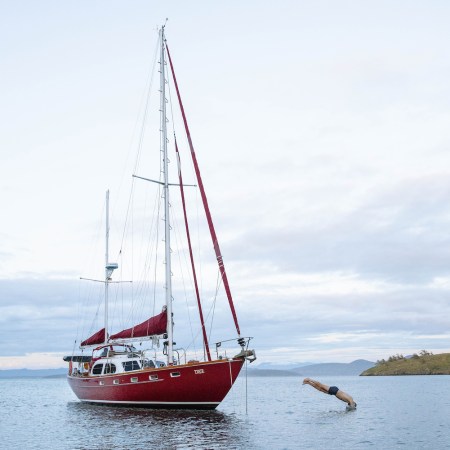From a distance, the boats look like children’s toys on a lake. It’s a sense heightened by the comparative lack of sound; the world is almost quiet, save for the rhythmic slap of the boats’ bellies on the otherwise calm waters. Only up close do you appreciate that these vessels, with their sleek, compact cockpits and sharp, extended noses, are barreling along in excess of 50 knots (57 mph). That they are piloted not by grubby-handed children, but professional pilots with everything to play for.
Powerboat racing enjoyed its noisy, high-octane heyday in the 1980s and ‘90s before slowly sinking from public consciousness. This new tour is not a return, but something else entirely. On February 3, the main event of the inaugural UIM E1 World Championship was held in Saudi Arabia — the first stop in the world’s first all-electric race-boat series. Eight teams took to the course, their pilots racing along the otherwise calm waters of Jeddah, a coastal city on the Red Sea.
Inspired by Formula E — the eco-friendly offshoot of F1 — E1 seeks to revamp what has previously been a brash and environmentally disruptive sport into something greener, and altogether more grown-up. Formula E has attracted interest from the likes of Leonardo DiCaprio; E1’s celebrity backers breathe equally rarified air. Among the eight team owners are DJ Steve Aoki, Didier Drogba (Chelsea FC’s fourth-highest goal scorer of all time), 22-time Grand Slam men’s tennis singles winner Rafael Nadal, Red Bull Racing’s Sergio Pérez…and one Tom Brady.
Such a group needs competition as a shark needs constant movement. “I know you guys are great champions, but it doesn’t matter,” Brady’s squarely-handsome face tells the group via Zoom before the first race. “We know who’s gonna win this: Team Brady. Let’s go!”
But, as with any new and vastly expensive sport (estimates put each boat around $650,000), the potential for mishaps is enormous. Team Brady co-team principals Ben King, 33, and Joe Sturdy, 32 work towards Brady’s famous guiding principle: “We have to win.”
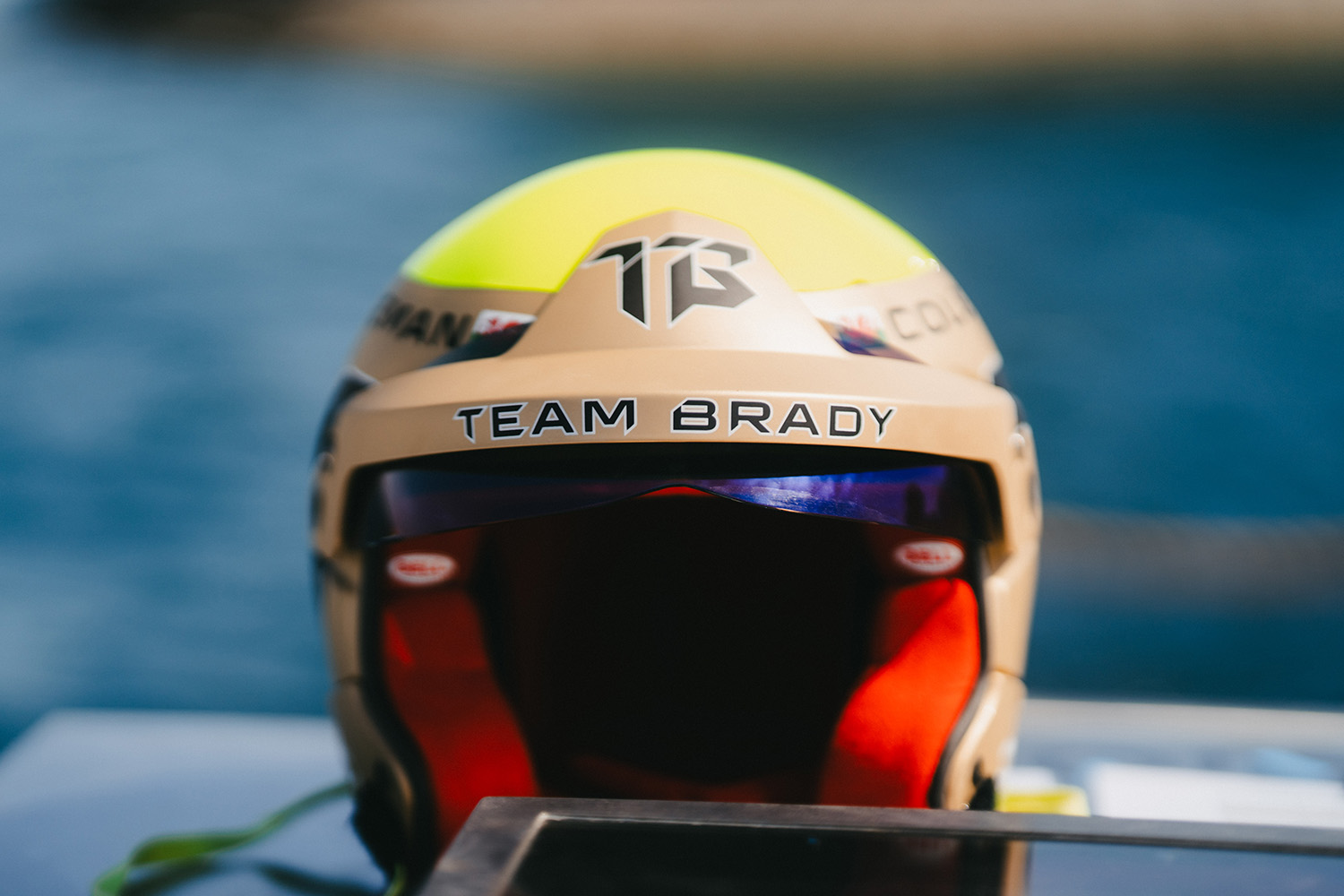
The TB12 Way
Watching the contests from the monitor bank in the race control building by the Jeddah waterfront — in his words, a “dark room with screens” — Sturdy says that half a lap into the first semifinal of the day, “It wasn’t looking good at all.” Their pilot, Emma Kimiläinen, 34, was plum last. “She got stuck in dirty water. It’s like in Formula 1, if you’re following the dirty air coming off the car in front, it massively affects your performance,” King explains. Amazingly, Kimiläinen managed to leapfrog three competitors to finish the lap in first place — and to finish the first ever E1 semifinal in first place overall.
In E1, each team goes through four heats, with just four boats racing at any one time, followed by two semifinal competitions per group, so that each of a team’s two pilots will race in a semi. The top four teams advance to the final, which is again split into two legs so that both pilots can race, with a team’s finishing position based on their performance in the final alone.
For the final race of the competition, it was Team Brady’s second racer, Sam Coleman, 39, in the pilot’s seat. Coleman came out of the first turn in third place, patiently weathering the chaos ahead of him — the boat in the lead massively jumpstarted by about three seconds and got a penalty, while the boat in second lost control during cornering by “hooking” their inside foil too deep in the water. For Sturdy and King, restricted to watching through TV screens, it was difficult to keep track of what was actually happening on the water, but it became clear that, out of nowhere, Coleman had suddenly taken the lead, crossing the finish line in first place.
Unlike, say, the 100-meter dash, E1 doesn’t operate on a first-one-over-the-finish-line-wins principle. Instead, it’s judged on a point system, one which, at this early stage, even the team principals were struggling to get to grips with. “Bear in mind, we had the 60 pages of rules sent to us three days before the event started. You get the points that are ordered for the first leg and then you add that to the points order for the second leg,” says King, who frantically worked it all out in his notepad in real time.
As the final ended, King shared his jottings with Sturdy; together they were fairly certain that they’d won. “I look around the room. No one else is celebrating and I say, ‘Okay I think we’ve won,’” says King, recounting possibly the most subdued sporting victory in history. When the news was finally confirmed by the race adjudicators, the team “went crazy,” recalls King. “It was pure elation.” For Brady, victory had never been in doubt. Watching from home, he messaged “Yes!!!!” in the team’s WhatsApp group. Race one, win one. Onto the next.
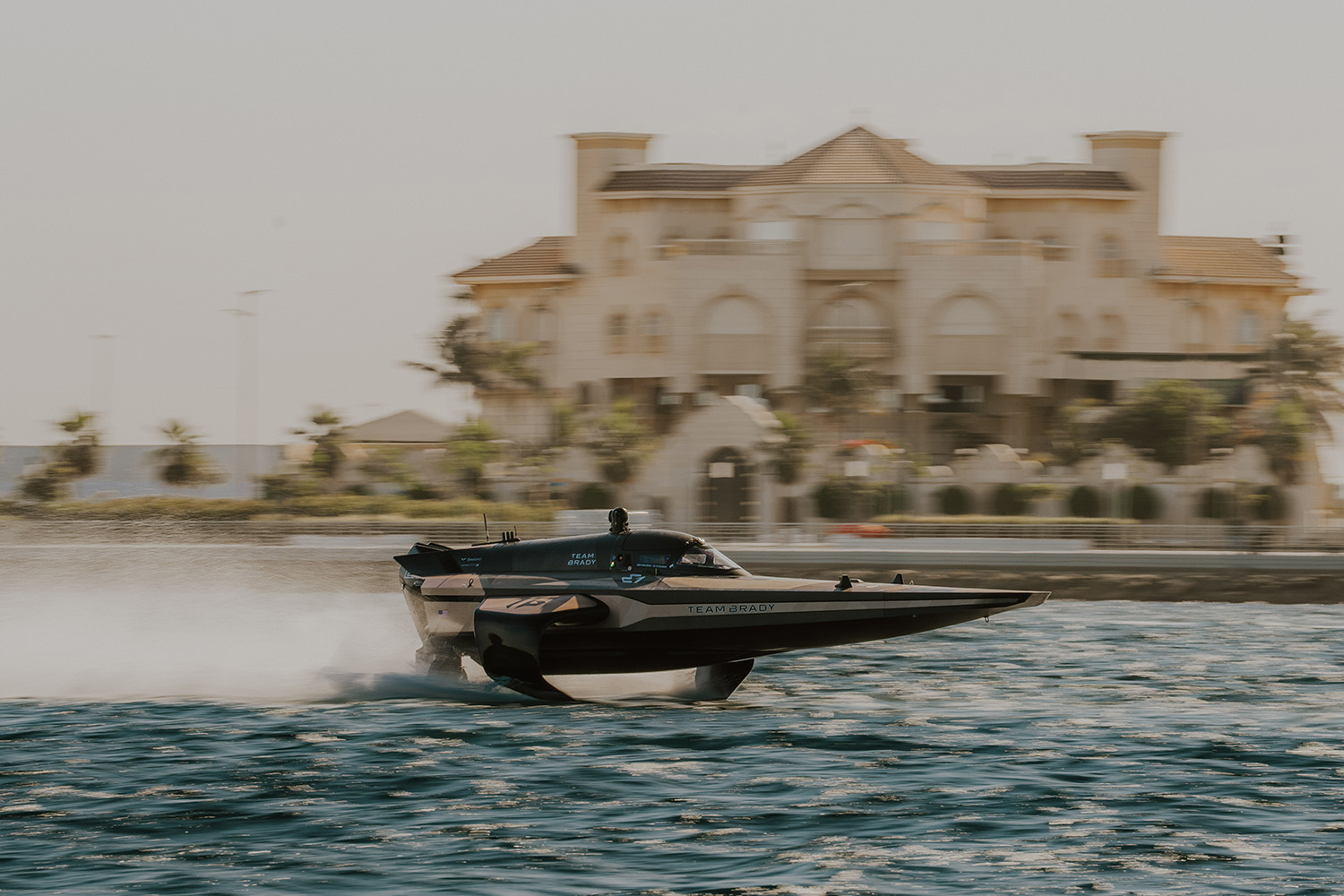
What Is E1, Anyway?
The E1 Series is a relatively new concept. It was dreamt up by Alejandro Agag, a Spanish businessman, and Rodi Basso, a former director of motorsport at McLaren, where King remembers him discussing the idea for E1 back in 2019. Agag had founded Formula E, along with Extreme E (the SUV off-road racing series), and Basso approached him with the idea of E1 during lockdown. Agag was in; reviving powerboat racing in a sustainable way seemed like the logical next step. The series was announced in 2021.
Much of the backing for E1 comes from Saudi Arabia’s Public Investment Fund (PIF), which recently announced a multi-year partnership called Electric 360, tying together Formula E, Extreme E and E1. It’s part of Saudi Arabia’s huge and well-documented drive to reposition itself as a global leader in sport, a move that has already seen the founding of the Saudi Pro League in soccer, and the LIV Golf league, both funded by the PIF. Following the Jeddah launch, the E1 Series will continue with a Venetian race in May, before cumulating in the Race to Hong Kong in November, with stops in Marbella, Monaco, Geneva and Rotterdam along the way.
To Get the World Excited About Electric Boats, E1 Offers a “Punch in the Face”
The team behind the RaceBird talks about their eye-catching vessel, and their hopes for the global racing series it will star inFor King and Sturdy, two down-to-earth British guys who attended Oxford Brookes University together (no, not the Oxford), the move into E1 made sense. After working as a partnership manager and advisor to the team principal at Virgin Formula E from 2015 to 2018, King carved out a career as head of business strategy at McLaren Automotive (the supercar side of McLaren) from 2018 to 2023. Sturdy did a master’s degree in engineering after his undergraduate studies, then took a role with Manor Grand Prix as an R&D engineer, before going on to work in trackside roles with Renault F1 and then Red Bull F1. He was Max Verstappen’s power-unit engineer, on the team that won 49 Grand Prix and three world championships.
“We’ve been thinking about doing something together for quite some time,” says King. “We were looking at Extreme E, but that was probably a bit of a pipe dream because it had already been going for a couple of seasons and the money required to get on the grid is quite big.”
King spoke to Basso again in 2022, expressing admiration that he had succeeded in making E1 a reality. Believing it was now or never, he convinced Sturdy it was time to join forces and put a team together. They began with a PowerPoint presentation, which they delivered to a number of potential investors without much success. An acquaintance advised them that their best bet was to get a celebrity backer on board. It just so happened that Tom Brady had recently been brought into the series and was looking for experienced people to run his own team. The stars had seemingly aligned and the three were brought together.
Tom Brady: Hiring Manager
King and Sturdy describe a virtual grilling from Brady’s business partner to make sure their ecological values and work ethic were aligned. Then, finally, they Zoomed with the man himself. “The one thing that we were told before we even had a conversation with them is that Tom and his team absolutely have to win,” laughs Sturdy. “It kind of piles on the pressure a little bit, but we approached that head-on, because we absolutely want to win it as well.”
“It was all a bit surreal,” he adds. “Having gone to various tests, seeing the first and second prototypes of the boat in Monaco…before we knew it we’re buying team kit, we’re ordering equipment, employing people and jumping on a flight to Jeddah for three weeks of madness.”
“The values of E1 are all things I believe in; we want to be the forefront of change and to leave the world in a better place than when we came into it. We’re all stewards of this amazing planet, and E1 is about making a positive difference and inspiring people to live in a more environmentally conscious way,” says Brady, who was unavailable for an interview, in a statement.
Sturdy thinks Brady was convinced to join forces with them partly because they were the only guys in E1 with a background in F1, and partly because of parallels between his career and Brady’s. “With Red Bull, we won all but one race last season, and with the Patriots, they won all but one game in their 2007 season,” he laughs. “Then there’s maybe the similarity that we’ve all seen sport done at the absolute highest level, and feel like we can drag powerboat racing in that direction.”
As part of his homework, Sturdy watched a documentary on Brady’s time with the Patriots and noted that the former quarterback would have a sit-down with his coach Bill Belichick every Tuesday. Now, Team Brady’s meetings are on Tuesdays too. (At the time of writing, King and Sturdy are yet to meet Brady in person.) King says Brady has given them autonomy to run the team, but that he’s also heavily involved, down to bringing in a design agency he’s worked with in the past and advising on the livery on the boat. “He’s cool. He’s really fired up about it,” says King. “We’re learning a lot from Tom and his management and, hopefully, they’re learning a lot from us in the process.”
It helps that the boats look cool, too. “E1 combines a lot of things that I love; to be on the water, great competition, and hopefully winning!” says Brady. “The boats look amazing, they’re so sleek, cool, modern — 100kph and fully foiling, exactly what you would think for an electric racing boat.”
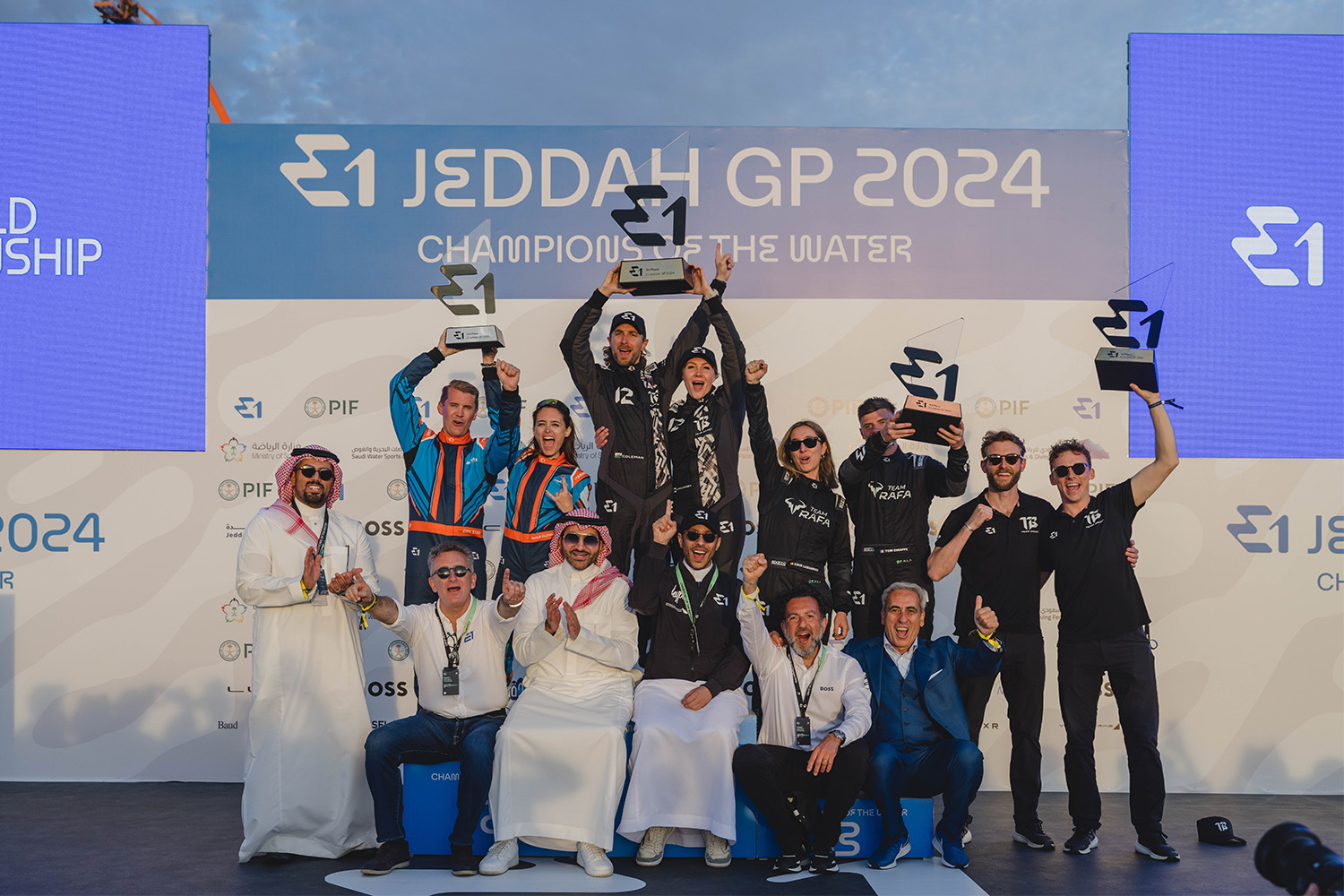
A Better Powerboat for the Planet?
Team Brady touched down in Jeddah three weeks before the first race. Before they could think about winning, King and Sturdy had some teething problems to address. It turns out that Jeddah was the first time all eight teams met up with their personnel and boats.
To begin with, all teams will use the same boat, in the same way that Formula E and Extreme E began with uniform cars and SUVs. Designed by SeaBird Technologies founder Sophi Horne, the RaceBird clocks in at seven meters in length and three meters in width, with a weight of just 1,764 lbs (800 kg). Add to that McLaren electronics, a Mercury power unit and a Kreisel high-voltage battery system, and you’ve got yourself a serious bit of kit. As Seabird’s PR materials add, “RaceBird boats are equipped with advanced electric propulsion systems and foiling technology, ensuring high performance with minimal environmental impact.”
Sturdy breaks down the piloting experience like this: “The pilots have four main controls that they use to balance the boats in the water. [They have] steering and throttle as you’d expect, and then they’re also able to use ‘trim’ and ‘lift’ to move the angle/height of the rear hydrofoil relative to the rest of the boat.” There’s also a handy boost button located on the steering wheel of each boat, which gives its pilot an increase in power for short periods.
According to SeaBird CEO Richard Draisey, the E1 Series is “a showcase for sustainable maritime innovation, aiming to spark a shift towards cleaner, electric solutions within the industry…. Seabird is developing breakthrough innovations in electric propulsion systems that will bring clean, quiet, efficient, high-performance systems to the leisure and commercial market.”
Indeed, E1’s official materials outline its commitments to “healing our coastal waters and ecosystems…through innovative clean technologies and aquatic regeneration.” To that end, marine ecologist Carlos Duarte has been recruited as E1’s chief scientist. Duarte is currently working alongside Ph.D. students to measure the impact the RaceBird has on the aquatic soundscape above and below the water.
“When RaceBird raced, noise levels where hugely reduced relative to that emitted by a similar-power combustion engine boat,” Duarte says. “In fact, the main feature captured by microphones above water was the singing of birds in the forest near the shore of Lago Maggiore, where the experiment was performed. In contrast, the strong noise emitted by the combustion engine vessel lead to birds going silent and giving up on attempts to communicate.”
Duarte’s team also found that the RaceBird noise was dissipated more quickly under water than a standard powerboat, while its foiling design created less turbulence on the surface. “And of course, the electric boat does not generate emissions of gasses derived from combustion, nor oils and other chemicals to the water column,” he adds.
“When you look at the marine industry, it’s probably a good 15, 20 years behind the automotive industry in its journey towards electrification and zero-emission technologies,” says King. “Being at the forefront of that change and driving that disruption has a lot of opportunities.”
Season three of E1 (scheduled for 2026) is when the teams will have full autonomy to enhance the technology in the RaceBird to their own design. For now, newly arrived in Jeddah and having recently completed a Pilot Academy in Italy, the pilots were just getting to grips with the RaceBird.
“So eight teams, two pilots to each, receiving the keys to the boat, essentially for the first time,” Sturdy recalls of those first days in Saudi Arabia. “They were pushing the limits of the boats immediately, going absolutely as fast as they could in a straight line and throwing it into a hydrofoil on the first corner. They identified issues that the series hadn’t identified with the boats before. So that was quite an interesting process. But we got the boats to a standard where we could race and not have any reliability issues, and we went through the entire race weekend with all boats finishing and not impacted in any way, which was remarkable.”
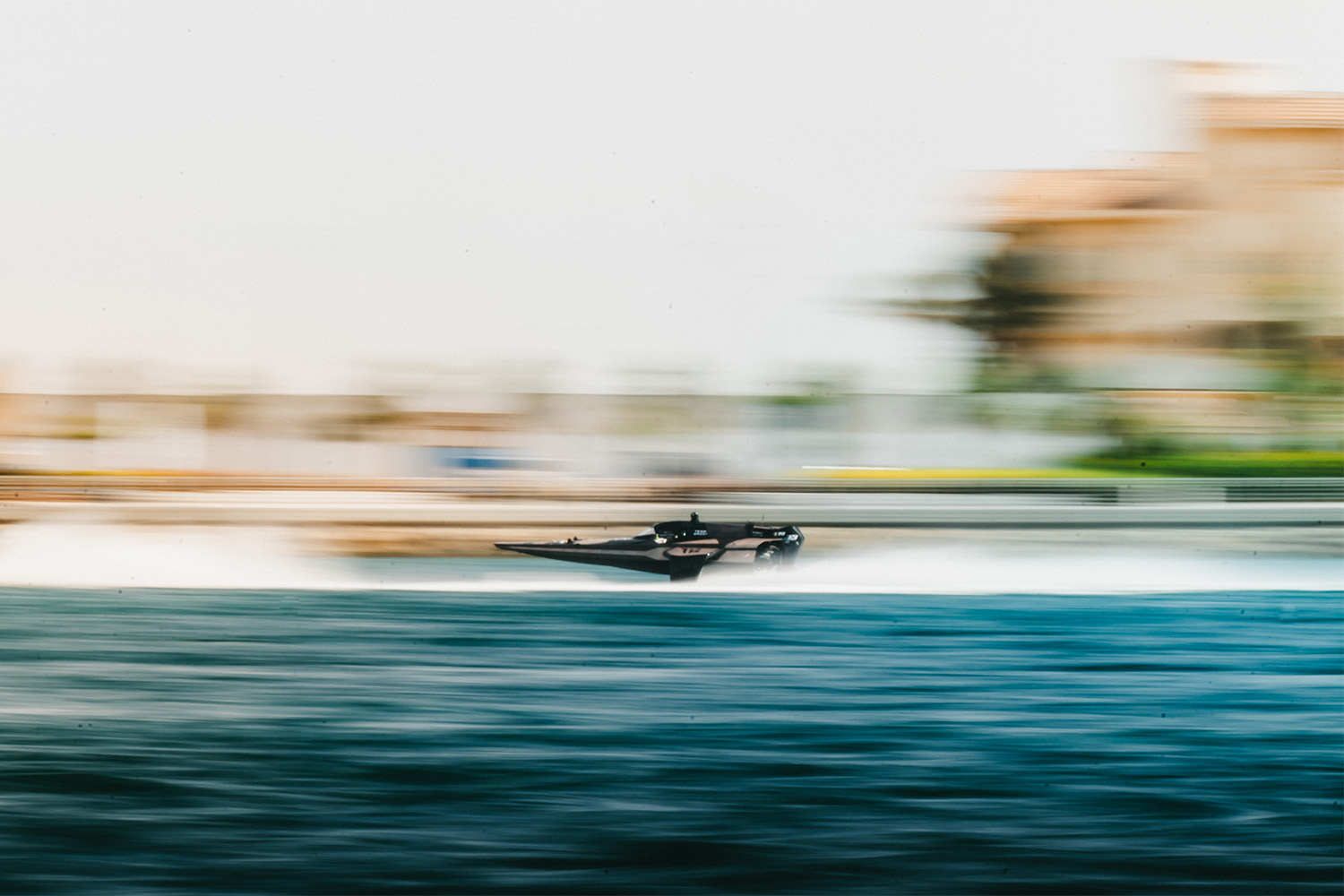
Calling All Pilots
Because E1 aims to attract people from different disciplines, only one pilot with a background in powerboat racing is allowed per team. “There’s rally drivers, Extreme E drivers, jet-ski racers — it’s a real mix and it just adds an extra dimension to the series,” Sturdy explains.
Sam Coleman began racing powerboats in 2016 after a successful motocross career. He says that the E1 RaceBird is “unlike any other powerboat — it doesn’t reward aggression or require huge physicality to drive. You must unlearn some of the habits that can make you fast in a more traditional race boat. Lose water pressure on the upper surface of the foil and you lose lift and stall, it can feel more akin to airplane than a boat…it requires a hyper focus to get the best out of the boat. It’s addictive, and visceral.”
Emma Kimiläinen’s background is in motorsport. The move to E1 came when she was contacted by the series and asked to take part relatively late, in September 2023. “I’m not a big fan of water and I’m pretty seasick, too,” she admits.
Despite never having driven a boat in her life before, she approached it with an open mind. She says “the thought of drowning feels the most uncomfortable,” but that handling the boat “requires the same talent as on land with any vehicle. It comes down to feel. Understanding the vehicle, feeling where its limits are compared to the surface and using your senses to make a comprehensive understanding of the situation.”
In other words: it’s a learning curve for all involved.
Whether Team Brady can continue to obey their namesake’s instructions to keep winning is a difficult question. One victory does not champions make. And there’s already talk of another team joining for Venice as the sport inevitably grows. For his part, King suggests eight to 10 teams would feel about right. Audiences seem to be keen to embrace this new entertainment, and its green credentials, too.
“I think now that race one has happened, it’s much easier for people to understand what this is about, and the potential it has,” King says. He adds that guests in Jeddah were already claiming the sport is more engaging than Formula 1, in part because they could see the entire course, not just a blur of a race car every 30 seconds.
“There’s gonna be a lot of educating and that kind of thing for fans,” he says, “but I think once they’re in, they’re gonna love it.”
The Charge will help you move better, think clearer and stay in the game longer. Subscribe to our wellness newsletter today.
